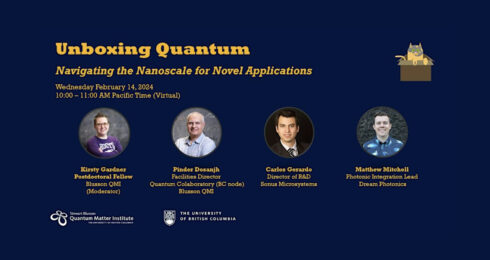Researchers in Ke Zou’s lab at the Stewart Blusson Quantum Matter Institute (Blusson QMI) are using quantum materials with intentionally created “impurities” to mimic brain activity for artificial intelligence applications. A new paper from Zou and colleagues, published in the journal Advanced Electronic Materials, highlights the influence of proton (hydrogen ion H+) incorporation—via low-cost topochemical techniques in a transition metal oxide lattice—and provides insight into their effects on resistive switching mechanisms. This efficient, cost-effective approach to fabricating quantum devices may bring the idea of a “brain on a chip” closer to reality.
Transition metal oxide materials have unique electrical and magnetic properties that make them a potentially useful platform for computer memory storage devices. Currently, many such devices are fabricated using silicon, but silicon memory devices have inherent processing limitations when scaled to smaller dimensions.
“Resistive random-access memory (RRAM) or memristor devices show promise as tools to achieve lower-cost, higher endurance processing that consumes less power,” said Srinivas Vanka, who co-authored the paper as a postdoctoral fellow in Zou’s lab, and who has since gone on to a role with a Vancouver-based nanotechnology company. “We believe that complementary metal-oxide-semiconductor compatible neuromorphic hardware can also address the ‘memory wall’ problem in computing.”
The “memory wall problem” is a major challenge facing modern computing, wherein advances in CPU processing speed have outpaced advances in memory speed: conventional microchips have more or less reached the limit of their ability to process information. To solve this, the team is working to develop novel memory devices using easily accessible materials that will facilitate automated data storage using analog memory devices.
“We’re using materials and techniques developed by Prof. Zou and others at Blusson QMI to create a new avenue for an entirely different memory architecture not seen in conventional silicon devices,” said Vanka. “This could be a game-changer.”
The researchers used a commercially available substrate (base material) and applied a thin film of metal. They then treated the surface of the material with a low-cost topochemical application to remove defects in the material and change the electrical properties of the underlying metal oxide in order to generate new properties. These new properties turn the material from a standard metal into a tool that can function like a synapse between artificial neurons. It is these properties the team is set to explore next, in collaboration with Max Planck-UBC-UTokyo Center for Quantum Materials (CQM) researchers.
“We believe a device like this could represent a turning point in our goal to simulate brain activity on a chip,” said Vanka.
In addition to its connection with the CQM, this work is an important contribution to Blusson QMI’s Grand Challenge in 2D materials.


